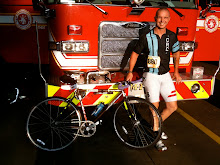I like snapping photos. I make the kids not-mug for pics, and snap lots of shots when they're playing or goofing or whatever. The ratio of average/indistinct/bad to great is quite large, and that's the way it goes.
Sensitive prep school boy photos of haunting homeless people remains a risk. What is, or how does one define, the line between compassionate witness and exploitation?
Klaus at Cycling Inquisition wrote about this yesterday--not-taking a shot of a lone, lost, beat-down rider at last year's Flanders. Are we really protecting the soul/privacy/? of the subject of the photo? Does it matter whether one snaps the pic and never shows it to anyone? That it was taken or that it's shown?
With my kid being sick over the holidaze, we've had umpteen opportunities to ponder this. Do I not-take Xmas morning pics because she's a gaunt ghost? Or, do I take them because this is where we are, this is a recording of this moment in time? Making the annual calendar for grandparents, I sifted through photos from the year: the now-obvious progressive diminishing of the kid over the summer & into the fall: should I edit out those images, or leave them in as marker/testimony to what WAS happening? There've been multiple opportunities to capture the howling anguish of her fighting with or surrendering to the disorder over the endless hours we've spent trying to coax nutrients back into her. WHY would I want to capture such anguish? For what purpose or to what end would I want to snap images for posterity? To show her later, when she'd regained her health--momento of where she was when she lost her bearings? Proof of the ordeal? Human capacity for pain?
I don't know. The mask of pain/fear/rage/panic that covered her face and self were haunting. Perhaps to capture it to bear witness, to keep me company--proof for myself, not her, later, that this WAS real.
When Flann waa little, she banged her head or butt or pride one evening when Annie & her sisters were trying to arrange a reenactment of a childhood photo. They were a bit stressed over the project, and the kid fell over, and, since I was taking the official photo, I had the camera handy and started snapping pics of the kid in her primal rage. Annie had a strong reaction: she felt very protective of the kid's helplessness or vulnerability. We argued about it. Why was I taking a photo of our daughter in a pique? (She wasn't hurt and I wasn't neglecting medical or emotional treatment.) I thought it was a strong image, and a rare one. I also can see the feeling that a photo taken of someone in a moment of turmoil captures something of their vulnerability--but does it take something FROM them? Is there anything to gain from the image?
After the fatal McMahon's fire in Mpls, a local Fox news guy wanted to film the fire-damaged helmet of one of the crew members who'd been at the fire. I was working & in charge when the reporter & his cameraman showed up at the station. There was something slimy, prurient, about how he asked about the helmet (it was badly burned, the shield melted; it was too damaged to be used again)--as if, because 'civility' wouldn't allow them to show the corpses from the apartment, they could substitute the helmet for the flesh. THIS charred helmet is all that we can show you of this horrible event, but, just imagine what the fire did to human flesh... I told the reporter to take off, albeit politely; he called the asst chief while I called my chief, who called the other asst chief. Lots of bugled phone tag. I won, if that's what it is, and the reporter skulked off. I wasn't able to effectively express to the asst chief the content of my wariness, but it felt wrong.
The contrary position: the charred helmet gave testimony to how dangerous the fire had been, what perils the crews had faced while searching for the (long-dead) inhabitants of the fire apartment & those other residents we'd helped rescue/escape. For people who weren't 'getting' that it was a bad scene, perhaps the helmet would bring that home. But, really, those who operate in the courts of superficial, uninformed/educated opinion seldom use fact or truth to cleanse their befogged lenses.
I'm left uncertain, still. It takes courage, or will or some-such, to stare blankly at something horrible. To capture something shocking or tragic or harrowing. But, once one is accustomed to the protection and filter of the camera, it's like a cloak--very easy to lose sight of the reality outside of the viewfinder.
5 years ago


No comments:
Post a Comment